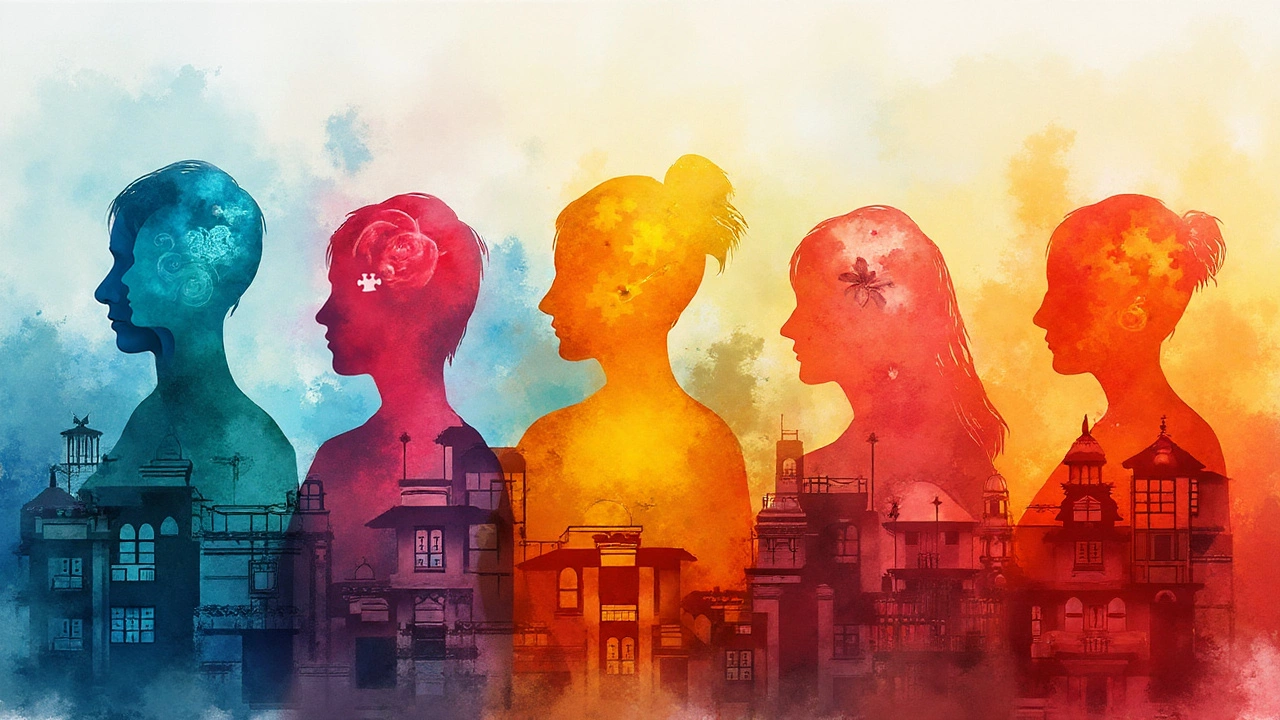If you think mental disorders are rare or distant, you might want to check the numbers: the World Health Organization reports that one in eight people worldwide lives with a mental disorder. This isn’t a distant issue. Someone you know—maybe even you—could be managing symptoms or silently struggling every day. That’s nobody’s fault. Brains are as individual as fingerprints, and sometimes, chemistry, genetics, experiences, or just pure bad luck can tip the scales. So let’s lay it all out: what are the seven main types of mental disorders, how can you spot them, and what does life really look like for people facing these challenges?
Anxiety, Mood, and Psychotic Disorders: The Power Trio That Shapes Minds
Anxiety disorders might make your heart race during a scary movie, but imagine that feeling popping up in the middle of a normal day—for no reason. These are more than jitters; we’re talking about phobias, panic attacks, and constant, nagging worry. Generalized Anxiety Disorder (GAD), panic disorder, and social anxiety disorder are familiar names here. According to the Anxiety & Depression Association of America, GAD affects nearly 6.8 million adults in the United States each year.
People with anxiety disorders sometimes dodge social events, avoid work or school, or can’t sleep thanks to worries that never quiet down. It’s not only about fear—restlessness, sweating, racing thoughts, and even physical symptoms like nausea can strike. Types of mental disorders aren’t always obvious on the surface, so it’s easy for folks to hide in plain sight. One cool tip that therapists use: grounding techniques, like taking note of five things you see or four you feel, can sometimes stop anxiety from spinning out of control.
Let’s shift gears to mood disorders, another heavyweight in the mental health ring. Depression and bipolar disorder are the most famous faces here. Depression isn’t just “feeling down”—it can suck the joy out of favorite hobbies, drain motivation, and even mess with appetite or sleep. A staggering 280 million people worldwide lived with depression in 2021, according to the WHO. Think about that: almost as many people as live in Indonesia!
Bipolar disorder confuses people because it’s not just about sadness; extreme highs (mania) alternate with crushing lows. People in manic states might take huge financial risks or barely sleep for days, only for despair to follow. If you’ve ever heard about creative geniuses with unpredictable moods, there’s a good chance “bipolar” was involved.
Let’s not forget psychotic disorders, like schizophrenia. These turn reality upside down: hallucinations, delusions, and confused thinking become everyday obstacles. Schizophrenia only hits about 1 in 300 people, but its impact is massive. The lines between what's real and what isn’t get blurry—imagine hearing voices nobody else can hear or believing you’re being followed without any proof. Treatment often involves antipsychotic medications, and early support really helps boost a person’s daily functioning.
| Type | Global Prevalence (%) | Typical Symptoms |
|---|---|---|
| Anxiety Disorders | ~4% | Worry, restlessness, racing heart |
| Mood Disorders | ~3.5% | Sadness, mania, loss of pleasure |
| Psychotic Disorders | 0.3% | Delusions, hallucinations, confused speech |
“Most people with mental health problems are closer to being ‘average’ than you’d think—the best way to help is to recognize the signs and listen.” — National Alliance on Mental Illness (NAMI)
A great thing to remember: Early intervention really makes a difference, so trust your gut if you notice something off, in yourself or those around you. There’s so much hope out there with the right support—and it often starts with a simple conversation.

Disorders That Mess With Behavior and Perception: OCD, Trauma, and More
Obsessive-Compulsive Disorder (OCD) gets tossed around in jokes, but there’s nothing funny about rituals that eat up hours every single day. People with OCD battle thoughts they can’t shake, plus repetitive behaviors—like handwashing or checking locks over and over. It can get so bad they avoid places or activities that trigger the urge. In the U.S. alone, more than 2 million adults have OCD.
Now, glance at trauma-related disorders. Post-Traumatic Stress Disorder (PTSD) isn’t just for veterans. Car accidents, natural disasters, violence—these can all leave scars that show up in nightmares, flashbacks, or panic at reminders of the event. About 6% of Americans will experience PTSD at some point. One thing that surprises people: women are twice as likely to have PTSD than men, probably because of higher exposure to certain types of trauma.
Eating disorders, like anorexia and bulimia, are serious mental illnesses—not about vanity but about control and deep psychological pain. They carry the highest mortality rate of any mental illness, and often appear in teens and young adults. Warning signs include drastic weight changes, obsession with food or exercise, or disappearing to the bathroom after meals. The National Eating Disorders Association estimates 28.8 million Americans will have an eating disorder in their lifetime.
Then there’s Dissociative Identity Disorder (DID), sometimes called “split personality”—though that’s not really accurate. People with DID have two or more “alters” or identities that take turns controlling behavior, usually after severe trauma. Forgetting big chunks of time or personal details is common. Shows like 'United States of Tara' brought some attention to this tough disorder, but real life with DID is full of complications most people can’t imagine.
Personality disorders, like borderline or antisocial personality disorder, show up as long-standing patterns that make relationships, work, or life in general a real struggle. People with these disorders may seem manipulative, dramatic, or distant, but beneath the surface, they’re often dealing with intense emotions or even fears of abandonment. About 9% of U.S. adults have some form of personality disorder.
Now, let’s clear up a common myth: People with these disorders aren’t dangerous or “bad.” They just see the world through a lens you might never have worn. That’s why understanding helps so much. For example, family support and group therapy can help people with personality disorders build stable relationships, something they often struggle with.
Need a pro tip? Regular routines, healthy boundaries, and patience save a lot of misunderstandings when supporting someone with a behavioral or personality disorder. Most importantly, keep judgment out of it—kindness works better than criticism every single time.

Neurodevelopmental Disorders, Addictions, and How to Help
Neurodevelopmental disorders, like ADHD and Autism Spectrum Disorder, often show up young. ADHD isn’t just “hyper kids”—it can look like daydreaming, trouble sitting still, or forgetting schoolwork. Over six million kids in the U.S. have an ADHD diagnosis, and many carry symptoms into adulthood. Meanwhile, Autism Spectrum Disorder affects social skills and behavior, with early red flags like no eye contact or trouble with language. For some families, getting a diagnosis early means more tailored support in school and daily life.
Substance use disorders are everywhere, but not always obvious. It’s not just “addiction” in the way we see in dramatic TV shows—sometimes it’s relying on prescription pills, binge drinking after work, or a habit that starts as a coping mechanism. According to the National Institute on Drug Abuse, about 20 million Americans over age 12 had a substance use disorder in 2022. That’s a huge group of people quietly battling cravings, guilt, and sometimes the law. Recovery is possible, and millions do get better, but it’s a rocky road. Support groups, therapy, and sometimes medication, like methadone or buprenorphine, are tried-and-true tools.
Then there are “unspecified” and mixed disorders. Sometimes, people have symptoms from multiple categories—maybe anxiety and substance use overlap, or depression and eating issues. Doctors now look for nuanced, real-world diagnoses so people can get the right kind of help, not just a label.
Now here’s something you probably haven’t heard: Early, kind intervention and a little creativity with routines and communication can make a huge difference for all these disorders. For kids with ADHD, short, positive feedback loops (like stickers or small rewards) can out-perform long lectures. For people dealing with substance use, open, shame-free conversations help more than blame.
Here’s a handy breakdown of the seven main types of mental disorders:
- Anxiety Disorders
- Mood Disorders
- Psychotic Disorders
- Obsessive-Compulsive and Related Disorders
- Trauma and Stress-Related Disorders
- Personality Disorders
- Neurodevelopmental and Substance Use Disorders
So, what’s the best first move? Ask questions, show up for people you care about, and don’t second-guess reaching out for professional support. With patience, openness, and science-based treatments, it’s completely possible to change the course of any of these disorders for the better. August 8 2025 0

Write a comment